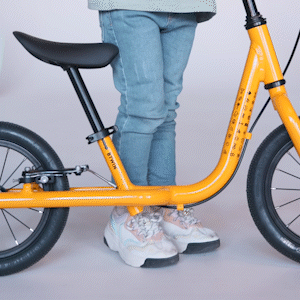6. WHAT IF MY BABY IS NOT INTERESTED IN THE BALANCE BIKE?
Pauline Sterckeman: “For children who are reluctant to use the balance bike, and if the experiment has failed outdoors, the ideal is to leave the vehicle inside (a little cleaning of the tires may be necessary). This way, you let your kids discover it on their own, at their own pace. They will gradually have the balance bike part of their play environment. If your child is moderately interested in the balance bike, you can also try to vary the approaches to succeed in finding the motivation lever that will speak to them."
Karine Roulin: "As you go, and without forcing them, you can also offer your child little missions during walks: go to the bakery to get bread, pick up leaves in the park, etc.,". To divert the attention from your child and reduce a form of pressure, you can go on a walk and accompany them by wearing inline skates or riding a scooter. Show them you are having fun too. You can add a small basket to the child's balance bike, like on your bike. The desire to imitate mom and dad, and to put their cuddly toy inside, will undoubtedly be a win!"
Pauline Sterckeman: “Have you immersed yourself in kids imagination? Connect to their universe and imagine, according to their interests, what their balance bike could turn into a scooter, animal, or rocket. To motivate them to get closer to their balance bike, suggest that they put gasoline in their "motorbike", "feed their dinosaur", "go on a mission to explore the moon", or "take their little dog to the vet", and as a bonus, you have a time of developmental growth!
Karine Roulin: "Disinterest in the balance bike can be because of poor environmental settings. If the child is uncomfortable, they will not want to do it. We therefore strongly advise you to check the environmental settings before each ride. If all your attempts prove unsuccessful, do not insist. It may be best to leave the balance bike aside or put it away for a while. Who knows? A kids reaction may be very different when they discover the balance bike next time!"






